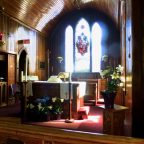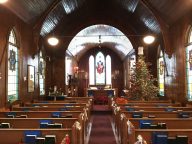May 12, 2017 Column
Old Cosmology, New World
Rev. Yme Woensdregt
Old maps used to have the words “Here Be Dragons” at their edges. Long before Columbus and modern cartography, mapmakers drew what they knew of the world. They were unsure of what was to be found at the edge of the known world.
It’s an amusing relic of a pre–scientific age. We know better today. There aren’t any dragons at the edge. In fact, there aren’t any edges. We’ve been to space, and we know now that there are other universes out there. Our world is a tiny fragile globe spinning in space.
Our knowledge has grown exponentially in such things. We’ve seen photographs of other planets, and tasted parts of outer space. When we look at ancient maps, we smile and move on. Pre–scientific concepts don’t bother us.
But all of that changes when it comes to matters of faith. Many scientific people today still cling to outdated, outmoded, pre–scientific ways of thinking. Christian faith originated in a culture entirely different from ours, and much of it is couched in language and images which we know to be wrong.
I bring this up because on May 25, the Church will celebrate the Ascension of Jesus. The way the Bible tells the story, Jesus ascends to the Father in the presence of his disciples. I have often thought that it might be an early version of “Beam me up, Scotty”.
Now we have to be clear that this story is told using pre–scientific images. Ancient people saw the world as a three–storey universe.
The top storey was where the gods lived. That’s not so hard to understand. Humans tend to think that up is good and down is bad. The level above us is described as the dome of the sky, or the area above the sky. In the Old Testament, this is known as heaven, or the heavens. God dwells in the heavens, above all else in creation.
The middle level is the earth. This is where humans live. It was often described as a flat disk, with mountains at the perimeter. It’s not so hard to understand why. If you’ve ever lived on the prairies, it becomes immediately apparent why the ancients would think of the earth as a flat disk, and the sky as a dome over the earth. Often in such a cosmology, the capital city was placed at the centre of the world.
The lowest layer was the underworld. This was usually the place where the dead went. The Old Testament calls it Sheol, the abode of the dead. Later, the place of the dead became identified as a place of eternal punishment. Hades became hell. I’ll have more to say about that in a future column.
This three–level cosmology was very common in the ancient world. Even today, our language continues to reflect it. We talk about “going up” to heaven, or pointing downwards when we mean hell.
So what does this have to do with Ascension? The Festival of the Ascension of the Lord celebrates Jesus’ return to the Father after the resurrection. The story is that Jesus goes up to be with God. The disciples remain on the earth, looking up into the sky, watching Jesus disappear.
Now, I don’t really believe that heaven is up there. In 1961, the first man in space, Yuri Gagarin, looked around and said, famously, “I don’t see any god up here”. Of course not. The three–storey universe is an image. The language of the ancients was not intended to be scientific or geographic description. It was symbolic, metaphorical language.
The challenge facing the church is to celebrate the central truths of our faith without being trapped by ancient cosmology and other ancient ways of viewing the world.
That’s not a new thought. Early church fathers treated this as metaphorical language. Let me give two examples. In the 5th century, Pope Leo taught that Christ ascended into the Eucharist, the feast of communion for the faithful. Martin Luther taught that Christ ascended, not to some distant place, but into the cosmos. There is a broad strand of teaching that as Christ went to God, he became available to all the church.
The truth which the Ascension affirms is that Jesus did not end his life in the grave. That was not his destiny. Rather, Jesus rose (note again the metaphor of “up”) from the grave, and rose (same image) to be with God. We don’t need to live in a three–storey universe to affirm this truth. In fact, what we need to do is reframe the ancient cosmology and restate this metaphor in ways that makes sense to 21st century people.
The heart of resurrection and ascension faith, it seems to me, is that just as death could not hold Christ, neither is death able to hold us. Paul says that we have already been raised with Christ. What is left for us is to accept that resurrection life now. It means to hunger for ways to fill that void that se feel at the centre of our lives. It means to work, and sometimes to work hard, to desire something beyond the day–to–day “ho–hum” of life.
We need only two things for that. The first is the desire that is unmet in our lives. The second is the willingness to risk going to God to fulfill that desire. Ascension, like resurrection, calls us to take a journey home to God. And, in the words of T.S. Eliot, “the end of our exploring / will be to arrive where we started / and know the place for the first time” (Little Gidding).







